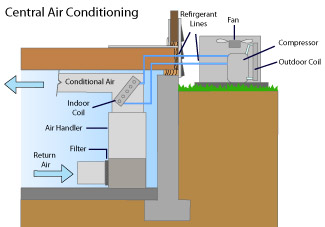In Business Since | License #
In Business Since | License #


A common practice when installing central air conditioning is to place the evaporator coil above the furnace’s existing blower and to use existing air ducts to distribute cooled air throughout your house.
A central air conditioning (AC) system relies on the same refrigerant compound that your refrigerator uses to "pump" heat from one location to another, thus providing cooling. In the evaporator coil of an AC system, the refrigerant compound is allowed to expand and change from a liquid into a vapor. In so doing, it gives up a great deal of heat -- just like perspiration does when it evaporates from your skin.
A blower in your AC system's air handler forces warm interior air through an evaporator coil, cooling the air before it enters the ducts that distribute the air throughout the house. Along with cooling, the AC system provides dehumidification, removing some of the moisture from indoor air.
Most homes with central AC have a standard "split" system similar to the one shown in the drawing. The exterior unit should rest on a level concrete pad; it contains the compressor that pumps the refrigerant through the system. The interior part of a central air conditioning system includes an evaporator coil and drain line for the moisture that condenses on it.
Dr. Energy Saver can provide central AC for homes across the country. Contact your local dealer today to see how our energy-efficient products can benefit your home!
Some central AC systems are actually heat pumps that provide cooling as well as heating. When hot weather ends and the heating season begins, a dual-mode heat pump can reverse the refrigerant cycle and begin to warm the air that is blown through your ductwork system. Air-source heat pump systems that supply heating and cooling work best in climates with mild winters. To work efficiently in a cold climate, a ground-source (aka geothermal) heat pump may be a better choice.
No matter how new or how efficient your central AC system is, you can't expect optimum efficiency if your ductwork system is faulty. As much as 20% of the air your central AC system supplies can escape through leaks in your ductwork. Sealing these leaks and insulating certain sections of your ductwork are affordable upgrades that will enable you to enjoy greater comfort and lower utility bills.
If your central AC unit is more than 12 years old, replacing it with an ENERGY STAR™ qualified model could cut your cooling costs by 30%. Dr. Energy Saver can provide a Free Estimate for replacing an old, inefficient system with advanced equipment that will save energy and improve interior comfort.
Looking for a price? Get a no cost, no obligation free estimate.